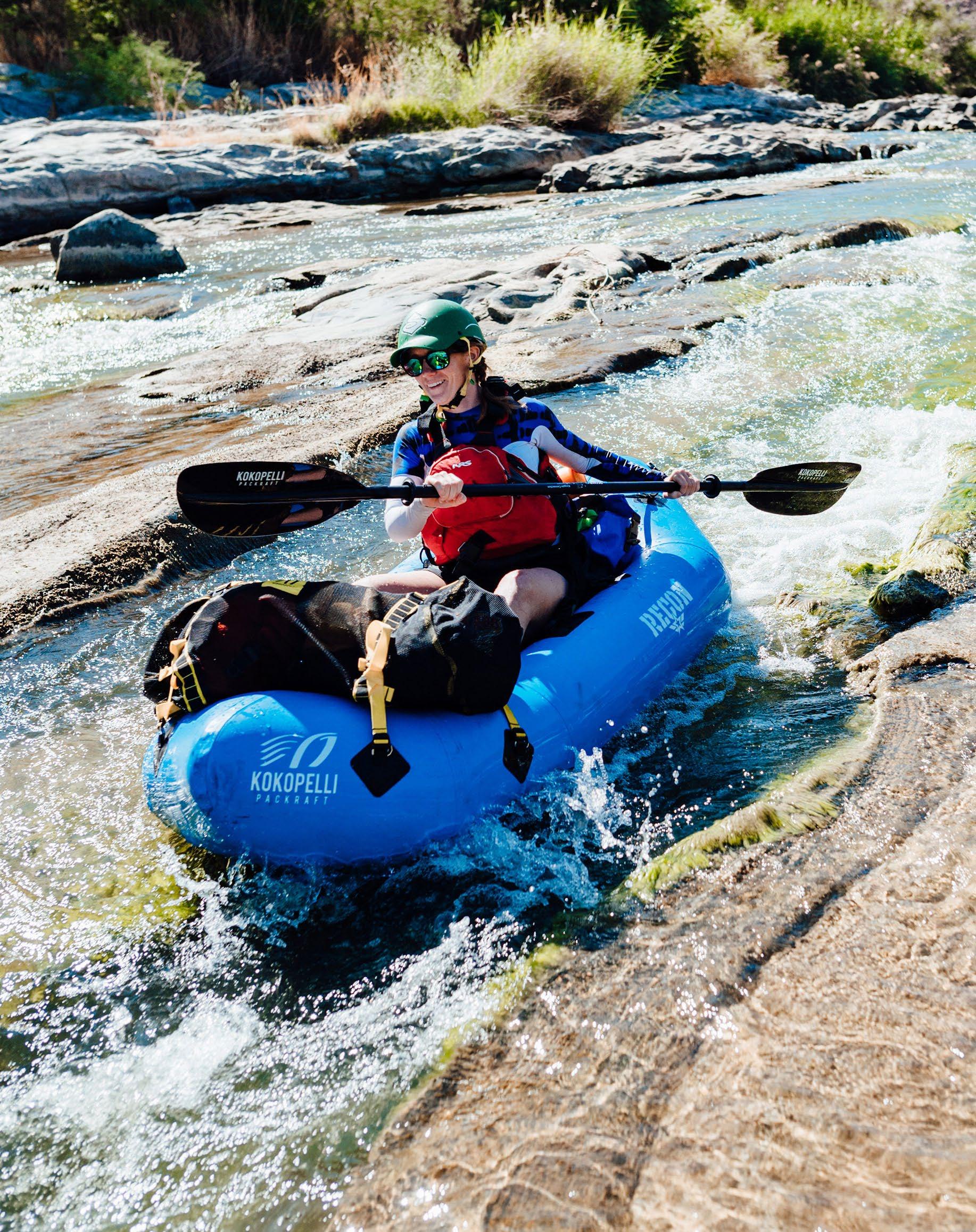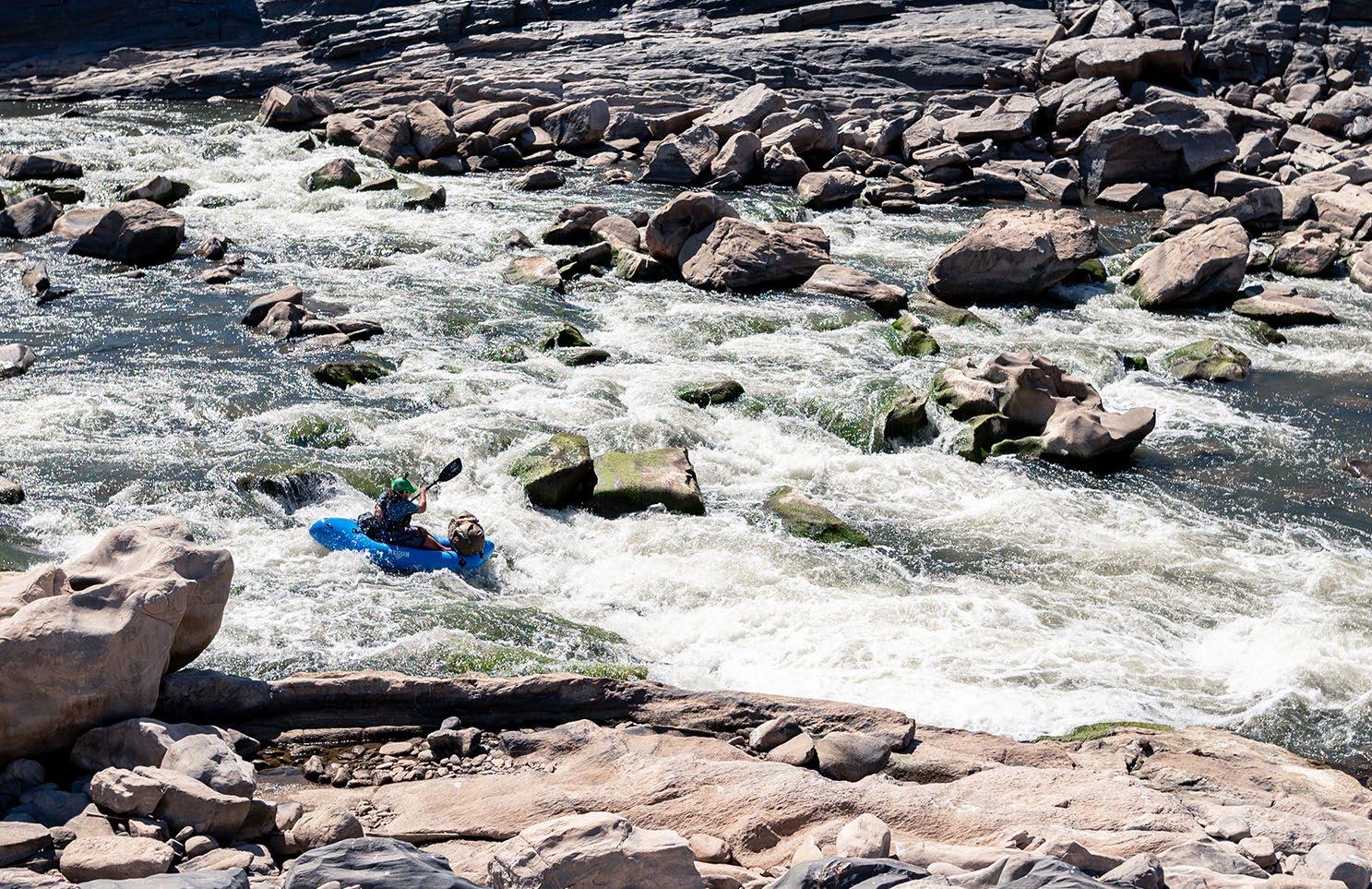
10 minute read
PACKRAFTING THE ORANGE RIVER
from Wild Traverse
Onseepkans, South Africa
Images & Story by Scott Martin
Advertisement
When it comes to taking a trip in the wilderness I’ve always been someone who throws caution to the wind and just says, “Yes.” And if it’s remote, my enthusiasm for the trip is heightened and I am driven to make it happen. For the past two years my wife worked in a corporate setting that involved longer hours at the office, less time off and way more energy spent dealing with the challenges that come with that world view. In that time it seemed like we “grew up.” Gone were the days of planning surf trips to Costa Rica, quick whitewater weekends to the Adirondacks and snowboarding mid week when the crowds were low and snow was at its best. So about a year ago we decided this lifestyle was not sustainable for us so we decided to take a trip back to my home country, South Africa, to unplug and reconnect with nature as well as each other.
For about fifteen years I worked as a raft guide on the Orange River in South Africa. The river’s desolate arid setting played a major role in my development. It was there that I learned to be comfortable in nature: sleeping under the stars, navigating gnarly rapids, setting up my bed away from scorpions; filtering river water for drinking and came to cherish a morning coffee as the sun rose over the desert mountains. I learned an important fact that is true of me today - the outdoors is what recharges, sustains me.

Seeing how hard my wife, Ashley, was working and the toll it was having on her daily life, had I pitched the idea that we go float the Onseepkans section of the Orange River for three days when we returned to South Africa. Having paddled the river a handful of times over the years, she loved the idea. So in the months leading up to the trip we discussed the logistics of how everything would run. It would only be the two of us – and that added a huge element of risk.
The Orange River is South Africa’s longest river, spanning 2500 km (more than 1500 miles). Its source is in the Drakensberg Mountain Range located in the independent, land locked country of Lesotho on the northeastern side of the country. The river twists and turns its way westward toward the west coast of South Africa where it empties itself into the cold Atlantic Ocean. The river forms an international border between South Africa and Namibia as well as South Africa and Lesotho. The river does not pass through any major cities. It plays an important role in the economy of South Africa by providing water, irrigation and hydroelectric power to the nation and many large farms found along its banks.


Onseepkans is a tiny village in the northwest region of South Africa where a small border post allows access to Namibia. It’s only open from 9am-5pm. There are two table grape farms, a church, butchery, liquor store, (there is always a liquor store in even the smallest towns in South Africa) and a small community of locals who live and work there. The closest hospital is about a 3-hour drive from the border post. Once you push off into the river and leave town behind, you are truly isolated in the backcountry: there is no cell phone service and no emergency support system like there is the states. Should something wrong while on the river, we would need to paddle out to the take out road, find the farmer and start calling for help – a process that could easily take half a day. We knew we would be isolated, alone and away from civilization, its what we wanted. And we were happy to roll the dice for it.
When we finally arrived in Cape Town, South Africa, my home town, we visited friends and family for a few days while collecting the last minute supplies we needed. Since it was going to just be the two of us, each in a packraft we needed to pack accordingly. This was not like the commercial rafting trips of my guiding days when boats were loaded fat with fillet steaks, large cooler boxes of beers in ice, dutch ovens and canvas tents. Ashley and I knew we needed to approach this trip with a “fast and light” mindset. This aspect of the trip allowed me to nerd out. I loved every minute of it. Though we would be going light, I still included a few luxuries like one cold beer each for each night on the river (‘cuz you know, it’s still a river trip and when it’s 85 degrees at 6pm, nothing is better than a cold one). Our goal was to keep it simple, eat vegetarian meals and enjoy every second. We used a Pelican cooler that allowed us to keep the beers cold and keep the cheese from melting.
I purchased a 1lb stick of Biltong. Biltong is a South African treat similar to jerky but significantly better in my opinion. That would be our treat, especially since it goes well with a cold beer.
Reports said the river was going to be low so hauling drinking water down the river was not an option. We used Grayl water purifiers. I was unsure about how they would handle the heat and silty water but I was highly impressed. Access to clean drinking water whenever we wanted it was a game changer. We didn’t need to pump or add chemicals to anything, just filled the bottle, press and we were good to go. With our supplies ready to go we loaded the two packrafts, food and camping equipment into the tiny Renault Kwid and drove the ten hours north to Onseepkans.

- SCOTT MARTIN

The Orange River does not get its name because the water is that color, although during flooding the topsoil washout can turn it orange. Dutch explorer, Robert Jacob Gordon named the river in honor of the Dutch ruling family at that time, The House of Orange. The river is well known for its diamonds; years ago a 15-year-old boy found the Eureka Diamond on its banks. After being cut, cleaned and weighed it was 24 carats. Some of the older people in Onseepkanse talk of the days they could walk the banks of the river and find rough diamonds.
We arrived to a very low river, possibly the lowest I’d ever seen it. My concern was whether we could get the packrafts down the wide river. There are many channels to navigate and with the water level low it would make navigating more difficult. Normally, the first day is spent paddling around a granite gorge; the gorge can be paddled at higher levels by experienced boaters due to the many siphons. The second day you portage a water fall, then drop into the gorge to paddle three class 4 rapids and the last day is spent exiting the gorge into one large, slow moving channel. We wondered whether we should even try since the water was low but, like I said, these situations tend to get me all fired up and excited so we decided to go. If it was too low we would pull off, eat all our food, and then hike up stream with the left over equipment back to the put in camp.

Pushing into the river with laden boats I felt like a kid; I even had a shit eating grin on my face. We were back on the Orange River, immersed in nature and really unplugged from the connected world. The boats handled the low water well; they sit pretty high on the water which allowed us to paddle around the shallow rocks. I let out a big scream, “Yewwww! We’re here.” The day was spent paddling in the sun, enjoying the solitude and each other’s company. We navigated a handful of class two rapids, grinning at each other when we hit the bottom because they where so much fun.
A small patch of sand surrounded by some trees set against a large cliff would make for a great camp. We were tired and figured out we’d covered close to 16km (10 miles). Once settled, we cracked open our beers and biltong to watch the sunset. Suddenly a troop of baboons appeared on the top of the cliff. They stared down at us inquisitively; soon small rocks were bouncing off the cliff straight down at us. I knew if they got into our camp and found our food they would eat it all. We had to get them away from us, as there was zero chance of fighting them off, there were close to 40 of them. We quickly collected some kindling and drift wood, I started a fire, hoping the smoke would rise against the cliff face up to their perch and keep them at bay. Luckily it did, I started banging my Chaco’s together to make
a large bang! That seemed to work, as they would go running after loud noise, but then they cautiously returned. As night fell they moved on down the river and we finally relaxed. Exhausted from the day we ate dinner and passed out at 8.30pm. In those moments before sleep I understood that this is exactly what we had come for - a connection with nature. This was where we wanted to be.
The baboons barking at each other woke us. A rude awakening because we had high hopes of sleeping in and enjoying a slow morning in the shade. Forced to pack up, we practiced proper Leave No Trace etiquette by taking all our trash down river with us. Paddling down stream to

the portage location, we descended into the gorge; carefully passed equipment down to each other in slow and steady movements; this was not the time or place to be playing silly buggers and risk a fall down the rock face. With such a light set up we made quick work of passing the gear down the hot rocks into the deep gorge. Next up was Big Bunny, the key rapid of the trip; a challenging class four. No one has any idea how or why it got that name since there are zero bunnies that live along the Orange River. Ashley had paddled Big Bunny before but due to the low water and rocky line she decided to portage. I would paddle both packrafts down and was delighted, until she asked what the emergency action plan was if I ended face down, unconscious. I reassured her that I’d be fine, but if it should happen: she needed to paddle down stream to the take out spot, get to the farmer there and call for help.
Our final day was short, just a 2 hour paddle down flat water to our take out. There the son of a local farmer met us and drove us back to Onseepkans. We arrived back at Red Rock Camp, our base camp to showers that felt like luxuries as the river dirt washed off. Having spent three days completely unplugged, focused solely on the goal of navigating the river safely, I began to understand that the pressures we put on ourselves, as we get older, are often just a state of mind. We can choose to put them aside and be in nature, in the moment, and see more clearly.

Scott Martin is a travel and lifestyle photographer and filmmaker. Born and raised in South Africa he now resides in the United States and frequently visits home. A passion for paddling rivers, travel, and unique cultures have led him around the globe while working with outdoor brands and NGO’s.
@Scott.Martin.Images






